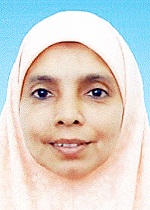Prediction of the Upper Flammability Limit of Pure Compounds
Keywords:
Abstract
A quantitative structure-property relation model was developed to predict the upper flammability limit (volume percent in air) of pure compounds, based only in their structures. A group contribution method was used to determine the upper flammability limit (UFL) through an artificial neural network. The method was used to identify the structure groups that have a significant contribution to the target property and concluded that 30 atom-type structure groups can represent the UFL for 550 pure substances. The models input parameters are the number of occurrence of each of the 30 structure groups in the molecule. The model predicts UFL with a correlation coefficient of 0.9996 and average absolute deviation of 0.17 vol %. The results were compared with multivariable regression model and other methods in the literature. The model is very useful and convenient for accessing the hazardous risk potential of chemicals for which experimental data is not available.
Downloads
References
Albahri, T. A. (2003a), “Flammability Characteristics of Pure Hydrocarbons”, Chemical Engineering Science, Vol. 58no. 16, pp. 3629-3641.
Albahri, T. A. (2003b), “Structural Group Contribution Method for Predicting the Octane Number of Pure Hydrocarbon Liquids’, Industrial and Engineering Chemistry Research, Vol. 42 no. 3, pp. 657-662.
Albahri, T. A. (2005a), “Molecularly Explicit Characterization Model (MECM) for Light Petroleum Fractions”, Industrial and Engineering Chemistry Research, Vol. 44 No. 24, pp. 9286-9298.
Albahri, T. A. (2005b), “Enhanced Method for Predicting the Properties of Light Petroleum Fractions”, FUEL, Vol. 85No. 5-6, pp. 748-754.
Albahri, T. A. (2012), “Prediction of the Aniline Point Temperature of Pure Hydrocarbon Liquids and their Mixtures from Molecular Structure”, J Molecular Liquids,Vol. 174, pp. 80-85.
Albahri, T. A. (2013a), “Prediction of the lower flammability limit percent in air of pure compounds from their molecular structures”, Fire Safety J, Vol. 59, pp. 188-201.
Albahri, T. A. (2013b), “Method for predicting the standard net heat of combustion for pure hydrocarbons from their molecular structure”, Energy Conversion Management, Vol. 76, pp. 1143-1149.
Albahri, T. A. (2014), “Accurate Prediction of the Solubility Parameter of Pure Compounds from their Molecular Structures”, Fluid Phase Equilibria, Vol. 379, pp. 96–103.
Albahri, T. A. (2015), “MNLR and ANN Structural Group Contribution Methods for Predicting the Flash Point Temperature of Pure Compounds in the Transportation Fuels Range”, Process Safetyand Environmental Protection,Vol. 93, pp. 182–191.
Albahri, T. A. and George, R. S. (2003), “Artificial Neural Network Investigation of the Structural Group Contribution Method for Predicting Pure Components Auto Ignition Temperature”, Industrial and Engineering Chemistry Research, Vol. 42 No. 22, pp. 5708-5714.
API (1987), Technical Data book - Petroleum Refining. The American Petroleum Institute, Washington, DC.
ASTM (1985), “ASTM E681-85 Standard Test Method for Concentration Limits of Flammability of Chemicals (Vapors and Gases)”, ASTM International, West Conshohocken, PA, www.astm.org
ASTM (2001), Chemical Thermodynamics and Energy Release, CHETAH V7.3; American Society for Testing and Materials, ASTM International, West Conshohocken, PA, www.astm.org.
Bunz A. P., Braun, B. andJanowsky R. (1999), “Quantitative structure-property relationships and neural networks: correlation and prediction of physical properties of pure components and mixtures from molecular structure’, Fluid Phase Equilibria, Vol. 158, pp. 367-374.
Dewan, A. (2006), “Experimental Project Results from the Design Institute for Physical Properties (DIPPR) of the American Institute of Chemical Engineers. 8”, J Chemical Engineering Data, Vol. 51 No. 6, pp. 1953 – 1953.
Elkamel A., Al-Ajmi, A. andFahim, M. (1999), “Modeling the Hydrocracking Process Using Artificial Neural Networks’, Petroleum Science and Technology, Vol. 17 No. 9-10, pp. 931-954.
Gharagheizi, F. (2009), “Prediction of upper flammability limit percent of pure compounds from their molecular structure”, J. Hazardous Materials, Vol. 167 No. 1-3, pp. 507-510.
Gharagheizi, F. (2010), “Chemical Structure-Based Model for Estimation of the Upper Flammability Limit of Pure Compounds”, Energy and Fuels, Vol. 24No. 7, pp. 3867-3871.
Gharagheizi, F., Ilani-Kashkouli, P. andMohammadi, A. H. (2012), “Corresponding States Method for Estimation of Upper Flammability Limit Temperature of Chemical Compounds”, Industrial and Engineering Chemistry Research,Vol. 51 No. 17, pp. 6265-6269.
Ismail, A., Soliman, M. S. andFahim, M. A. (1996), “Prediction of the viscosity of heavy petroleum fractions and crude oils by neural networks’, Sekiyu Gakkashi, Vol. 39 No. 6, pp. 383-388.
Joback, K. G. (1984), Thesis, Massachusetts Institute of Technology, Cambridge Massachusetts.
Lasdon, L. S., Waren, A. D., Jain, A. and Rather, M. (1978), “Design and Testing of a Generalized Reduced Gradient Code for Nonlinear Programming”. ACM, Vol.4 No. 1, pp. 34-50.
Lazzus, J. A. (2011), “Neural network/Particle swarm method to predict flammability limits in air of organic compounds”, ThermochimicaActa,Vol. 512 No. 1-2, pp. 150-156.
Lee, M. J. and Chen, J. T. (1993), “Fluid Property Prediction with the Aid of Neural Networks”, Industrial and Engineering Chemistry Research, Vol. 32No. 5, pp. 995-997.
Lippmann, R. P. (1987), “An Introduction to Computing with Neural Nets. IEEE ASSP Magazine, Vol. 3 No. 2, pp. 4-22.
Molecular Knowledge Systems, Inc. (1998), Cranium V1.0.3, Property Estimation Software (http://www.molknow.com/).
Pan, Y., Jiang, J. and Wang, Z. (2007), “Quantitative Structure-Property Relationship Studies for Predicting Flash Points of Alkanes Using Group Bond Contribution Method with Back-propagation Neural Networks”, J Hazardous Materials, Vol. 147 No. 1-2, pp. 424-430.
Patel, S. J., Ng, D. andMannan, M. S. (2009), “QSPR Flash Point Prediction of Solvents Using Topological Indices for Application in Computer Aided Molecular Design”, Industrial Engineering Chemistry Research, Vol. 48No. 15, pp. 7378–7387.
Reid, R. C., Prausnitz, J. M. and Polling, B. E. (1987), The properties of gases and liquids, Hill; New York, N.Y.
Seaton, W. H., Freedman, E. andTreweek, D. N. (1974), “CHETAH-The ASTM Chemical Thermodynamic and Energy Release Evaluation Program, ASTM DS 51”, American Society for Testing and Materials, ASTM International, West Conshohocken, PA, www.astm.org
Sheldon, M. (1984), “Study of the Flammability Limits of Gases and Vapors”, Fire Prevention, Vol. 14, pp. 23-31.
The MathWorks Inc. (2001), MATLAB V6.1, Neural Network Toolbox (http://www.mathworks.com/).
Widrow, B. and Lehr, M. A. (1990), “30 Years of Adaptive Neural Networks: Perceptron, Madaline, and Backpropagation’, Proc. IEEE,Vol. 78 No. 9, pp. 1415-1442.
Downloads
Published
How to Cite
Issue
Section
License
Copyright (c) 2016 Asian Journal of Applied Science and Engineering

This work is licensed under a Creative Commons Attribution-NonCommercial 4.0 International License.








